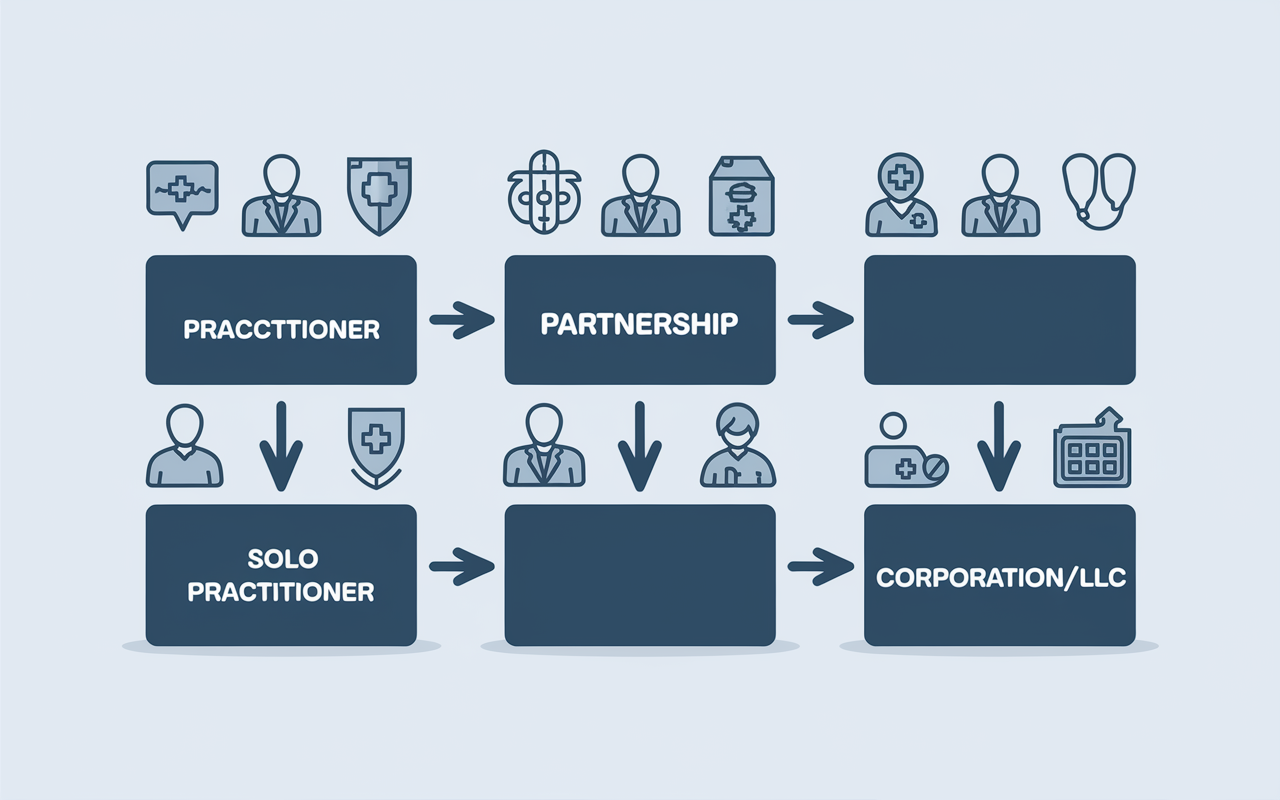How to Create a Business Plan for Your Private Practice: A Step-by-Step Approach
Starting a private practice can be a fulfilling venture that offers you the opportunity to provide personalized care and foster strong relationships with your patients. However, to ensure long-term success and sustainability, creating a well-structured business plan is vital. This comprehensive guide will walk you through the essential steps to develop a robust business plan for your private practice.
Introduction
A business plan serves as a road map for your practice, outlining your vision, goals, strategies, and financial projections. Whether you are an experienced healthcare provider delving into entrepreneurship or a fresh graduate seeking to establish your practice, a thoughtfully crafted business plan is crucial for navigating the intricacies of running a private practice.
Why You Need a Business Plan
A solid business plan offers several benefits:
- Clarity of Vision: It helps you define your practice's goals and mission.
- Funding Opportunities: If you're seeking loans or investors, a compelling plan increases your chances of securing funding.
- Operational Guidance: It provides a framework for daily operations, helping you make informed decisions.
- Market Understanding: It offers insights into your target audience and competitive landscape.
With the importance of a business plan established, let's dive into the step-by-step approach to creating one for your private practice.
Step 1: Define Your Practice Concept 
The first step in creating a business plan is to clarify your practice concept. This includes deciding on the specialization and the scope of services you'll offer. Consider the following points:
- Area of Specialty: What kind of practice do you want to establish? Family medicine, pediatrics, psychiatry, or another specialty?
- Target Patients: Who is your ideal patient demographic? Consider age, gender, socio-economic background, and specific health needs.
- Service Offerings: Will you offer routine check-ups, specialized treatments, telemedicine, or integrated health services?
Example:
If you're a psychiatrist focusing on treating anxiety disorders, your practice concept might involve providing comprehensive therapy, medication management, and support groups for both adults and adolescents.
Step 2: Conduct Market Research 
Understanding the market landscape is crucial for identifying opportunities and challenges. This step consists of analyzing your competition, understanding potential patients, and assessing local healthcare needs.
- Competitor Analysis: Identify existing practitioners in your area. What services do they offer, and what is their pricing structure? Analyze their marketing strategies.
- Patient Needs Assessment: Conduct surveys or interviews with potential patients to identify their needs and preferences.
- Healthcare Trends: Stay updated on the latest trends and shifting needs in healthcare that can impact your practice.
Example:
If your research reveals a lack of mental health services specifically addressing adolescent patients in your area, it may indicate a unique opportunity for your practice.
Step 3: Outline Your Business Structure 
Choosing the right business structure for your practice is essential. Options include:
- Solo Practitioner: You’ll operate independently, making all decisions.
- Partnership: You can partner with another physician or provider, sharing responsibilities and profits.
- Corporation or LLC: These structures can limit your personal liability and offer potential tax benefits.
Define your business structure and your role within it. Additionally, consider aspects such as how ownership will be divided in the case of partnerships and how management responsibilities will be delegated.
Example:
You decide to form a single-owner LLC for liability and tax benefits, which will allow you to protect personal assets while also taking advantage of specific tax deductions.
Step 4: Create Your Marketing Strategy 
Marketing is key to attracting patients to your practice. Your strategy should incorporate both online and offline methods to boost visibility.
- Online Presence: Build a professional website, optimize it for search engines (SEO), and create social media profiles. Consider offering informative blogs or videos that highlight your expertise and connect with potential patients.
- Community Outreach: Attend local health fairs, offer free workshops, or partner with schools and organizations to raise awareness about your services.
- Patient Referrals: Create a referral program with other healthcare providers. Encourage satisfied patients to share their experiences and refer friends or family.
Example:
Leverage social media to host live Q&A sessions about managing anxiety, thereby establishing yourself as a trusted resource for mental health issues.
Step 5: Develop Financial Projections 
Understanding your financial needs and projecting your revenues and expenses is crucial for keeping your practice afloat. This section of your business plan should include:
Start-up Costs:
- Equipment and supplies
- Office space or lease costs
- Staffing (if applicable)
- Marketing expenses
Projected Revenue:
- Estimate patient volume based on market research. Define expected fee-for-service rates and potential insurance reimbursements.
Break-even Analysis:
- Calculate how long it will take to cover your start-up costs and maintain profitability.
Example:
You determine initial costs will be $150,000, estimate monthly revenue of $10,000 in year one, with expectations to break even by month 15.
Step 6: Write the Executive Summary 
The executive summary provides a snapshot of your entire business plan. This section should be concise, yet it must encapsulate your mission, key objectives, and the unique value your practice offers. Aim for clarity and impact.
Example:
“[Your Practice Name] is dedicated to providing comprehensive, patient-centered mental health services tailored to adolescents. With a focus on evidence-based treatments, our mission is to enhance the emotional well-being of our young patients while creating a supportive and nurturing environment.”
Step 7: Create an Operations Plan 
Your operations plan outlines everyday processes, including:
- Office Management: Describe how your practice will be organized, who will handle administration, scheduling, and patient records.
- Staffing Plan: Identify staff roles and responsibilities. Will you hire a receptionist, nurse, or administrative personnel?
- Quality Assurance: Outline procedures to ensure high standards of care, including regular staff training and patient feedback protocols.
Example:
Your operation plan indicates routine staff training sessions every quarter to improve communication skills and service delivery.
Step 8: Risk Assessment and Management 
It’s essential to identify potential risks and how you will manage them. This includes both financial and operational aspects:
- Financial Risks: Price increases, unexpected expenses, or fluctuations in patient volume.
- Operational Risks: Challenges in recruiting qualified staff or dealing with increased competition.
Create a risk management strategy to mitigate these risks. This might include emergency funds or implementing contingency plans.
Example:
Preparing for a potential financial shortfall by maintaining a reserve fund equivalent to three months of operating expenses.
Step 9: Seek Feedback and Revise Your Plan 
Once your business plan is drafted, seek feedback from peers or mentors in the medical field. Use their insights to refine your plan, ensuring it addresses all necessary elements and clarifies your vision.
- Review and Revise: Regularly revisit your business plan to make updates reflecting changes in your practice situation or the healthcare market.
Example:
You update your marketing strategies after receiving feedback that highlights the competition's success with digital ads.
Conclusion
Creating a business plan for your private practice is an extensive yet rewarding process. It lays a solid foundation for your professional journey as you venture into establishing your practice. By following this step-by-step approach, you'll be equipped to navigate the challenges ahead, ensure sustainability, and provide top-quality care to your patients. Remember, a well-thought-out business plan isn’t just a document—it’s a living guide that will evolve as your practice grows.
FAQ Section
Q1: How long should my business plan be?
A: An effective business plan typically spans 20-30 pages, focusing on clarity, relevant details, and logical structure.
Q2: Is it necessary to include a financial section if I am self-funding my practice?
A: Yes, it’s essential to outline your finances, even if self-funding, to understand profitability and cash flow.
Q3: How often should I review my business plan?
A: Regularly review and adjust your business plan at least once a year or whenever significant changes occur to your practice.
Q4: Can I get assistance in developing my business plan?
A: Yes, consider involving professionals such as business consultants, accountants, or mentors who specialize in healthcare.
By following these steps, you can build a solid framework for your private practice that not only reflects your personal values but positions you for lasting success and meaningful patient impact.

SmartPick - Residency Selection Made Smarter
Take the guesswork out of residency applications with data-driven precision.
Finding the right residency programs is challenging, but SmartPick makes it effortless. Our AI-driven algorithm analyzes your profile, scores, and preferences to curate the best programs for you. No more wasted applications—get a personalized, optimized list that maximizes your chances of matching. Make every choice count with SmartPick!
* 100% free to try. No credit card or account creation required.












